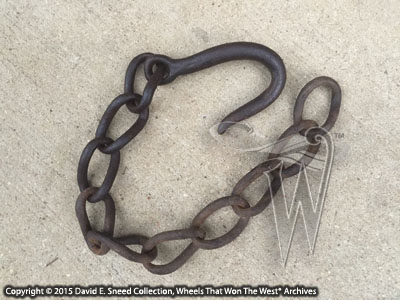Over the years, I’ve talked a lot aboutthe different types of technology employed in early wooden wagons. For some, these old wheels seem extremelysimple. The original builders and usersof the vehicles, though, understood just how difficult it was to keep wood heldtogether correctly and successfully. Afterall, virtually all of the outdoor elements worked against it – dirt, moisture,dryness, sun, rough terrain, heavy loads, and more. With so much stacked against them, I’msometimes amazed that any of these vehicles have survived.
Because of my intrigue and continualresearch on this subject, I’m often asked questions related to who did what andwhen. I’m also asked the “whys” ofdifferent vehicle types and technologies. Answering some of those questions can be even tougher when thequestioner is looking to confirm answers with primary sources. As an example, some time ago, a reader askedme if I had ever seen references to the purpose of ‘stay chains’ in nineteenthcentury materials? It was an unusualquestion that led me to one conclusion – That at least some of the information manyof us believe we know is likely limited to our own modern dayexperiences or what our grandparents might have passed on. While both oral history and personaldiscovery are important, neither can completely take the place of earlier primarysources.
Even though I haven’t deliberately gonelooking for details on stay chains, I have kept the question in the back of mymind. As fortune would have it, a fewmonths back, while I was reviewing some Civil-War-era records, I came across areference to a doubletree innovation that mentioned the purpose of staychains. For many, the answer may seemobvious. The fact remains, though, thatfor any of us to truly connect with the way wagons and western vehicles werelooked upon in their time, we must base our understanding in the documentationleft within primary sources.
 |
| Stay chains are positioned to work hand-in-hand with the doubletree to optimize the leverage and power efficiencies of draft animals hooked to a wagon. |
For those unfamiliar with the locationof stay chains, they are typically attached to hooks positioned near the outerends of a wagon’s front axle. The otherend of each chain (two total) is then attached to the corresponding outer portionof the doubletree.
The 1865 document I stumbled acrossdetailed the function of a newly-developed doubletree equipped with a counterbalancingcenter spring. To digest the fulldescription below, you may have to read it a few times as it does get a bitwordy. Ultimately, the writer does aninteresting job of explaining both the complexity and purposes of a doubletreeand stay chains...
“...From theforegoing description it will be understood that in using my improveddoubletree, the changing point of draught will always correspond with thedifference in power applied to the ends of the doubletree. In every instanceand condition the doubletree will adjust itself upon the fulcrum-block in sucha manner as to favor the less powerful horse, because, as the more powerful ofthe two will keep in advance of the other, the point of draught willcorrespondingly approach and remain in nearer proximity to the most advanced ofthe animals. In other words, theforemost horse will necessarily have the short end of the lever, while therearmost will draw from the longer end. In the event of the entire suspensionof power at one end of the doubletree, then the stay-block will operate tocheck and hold the doubletree from oscillating to any considerable extent, servingthe purpose of stay-chains, which are generally required for the same purpose...”
Simply put, properly-used stay chainshelp ensure that optimum leverage is available to a team drawing a wagon,thereby allowing for easier pulling and overall wagon operation. Clearly, the references to technical termslike fulcrums, leverage, power, and point of draught can get a bitcomplicated. That said, the descriptionhelps demonstrate that quite a bit of math and science went into the design of eventhe smallest of parts. Ultimately, theengineered designs were crafted to enable the wagon to function with thegreatest efficiency, effectiveness, and longevity while providing the means fordraft animals to optimize power.
Whew! So much for simplicity. Soundsmore like geometry, physics, science, and algebra classes to me! I realize today’s blog wasn’t exactly a casualread. From time to time, though, we’ll share afew pieces like this to help reinforce the contributions of early builders anddesigners while also highlighting the true complexities of their craft.
Please Note: As with each of our blog writings, all imagery and text is copyrighted with All Rights Reserved. The material may not be broadcast, published, rewritten, or redistributed without prior written permission from David E. Sneed, Wheels That Won The West® Archives.
Please Note: As with each of our blog writings, all imagery and text is copyrighted with All Rights Reserved. The material may not be broadcast, published, rewritten, or redistributed without prior written permission from David E. Sneed, Wheels That Won The West® Archives.